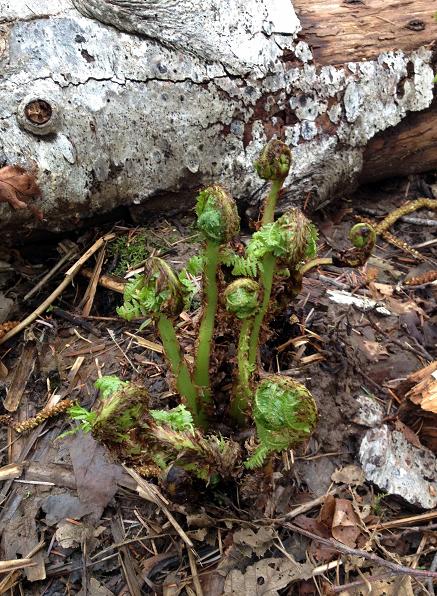 This year’s non-winter has accelerated the growth of not only my herb garden, but all the greenery on the island. The footpaths and bike trails are ablaze with tiny neon-green shoots a month or so earlier than expected and font yards are dotted with confused-looking crocuses and daffodils.
This year’s non-winter has accelerated the growth of not only my herb garden, but all the greenery on the island. The footpaths and bike trails are ablaze with tiny neon-green shoots a month or so earlier than expected and font yards are dotted with confused-looking crocuses and daffodils.
It’s time to get foraging! The local bogs are full of various strange and wonderful plant life that can only be harvested for food during this early stage of growth. The vanguard of these spring edibles are fiddleheads: Immature ferns that spend only a couple ‘o weeks each year as tightly-curled delicacies resembling the head of a violin before opening up and becoming just another leaf adrift in the great ocean of green.
Ferns live in swamps, bogs and anywhere that’s moist, squishy or near to running water. They tend to congregate together under conifers and tolerate the company of Oregon grape, salmonberry, skunk cabbage and discarded Lucky Lager cans.
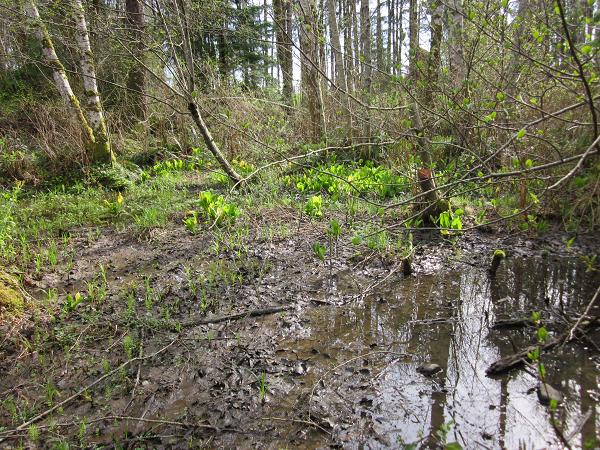
What you will need to forage for fiddleheads
Boots –You’re reaching for a fiddlehead and shift your footing, planting it into three inches of semi-liquid sludge. Avoid ruining your nicest footwear and bring your mucky-mucks instead.
Gloves – The little feathery-bits that cover the coiled tops of the ferns will stay shellacked to your fingers all day, so bring a pair of gloves to avoid this.
Plastic or Paper Bag – Got to get ‘em back to the kitchen somehow.
I ventured out into the local Beaver lodge Lands with Velvet to see what was poking up through the muck and found a couple ‘o different types of ferns, some delicious and some mildly toxic. In an effort to keep my dinner (and yours!) on the up and up, we’ll look at the various forest denizens that get collectively labeled as “fiddleheads”:
Ostrich Fern – The big-daddy of edible spring ferns! This thick, tasty spiral of greenery is abundant on the East Coast of Canada, but less likely to appear in our rainforests. It grows from five to eight fronds from each rhizome. Each is thick, emerald green and has a deep groove running along the entire underside of the stalk like a celery stick. The spiral is covered with a light brown paper bag-like covering that will disintegrate at the slightest touch. It’s so safe to eat that it often appears in grocery stores in the early spring months.
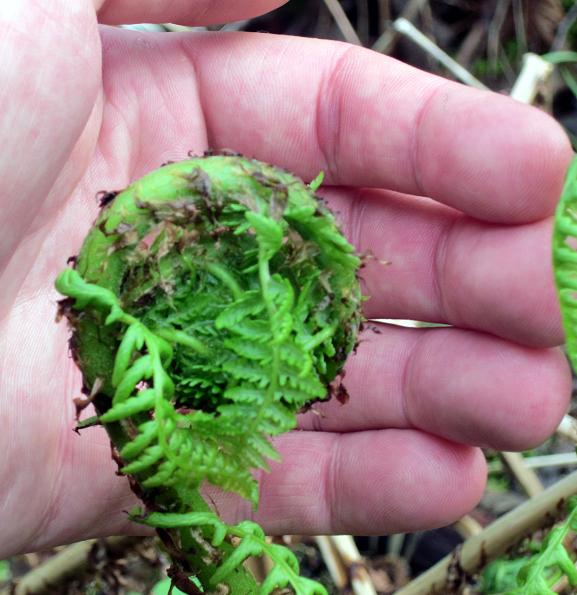
Lady Fern – This species of fern is ubiquitous on the West Coast in damp, shaded areas and resembles the Ostrich Fern in a couple of ways: It’s got five to eight ferns per rhizome, it’s compact and tightly coiled at the head and even has a slight groove running along it’s underside. Unlike its East coast cousin the head of the Lady Fern is covered in sticky dark brown or black feathers that can be scraped off easily with a fingernail. These guys are okay to eat after careful cleaning and a blanching in boiling, salted water.
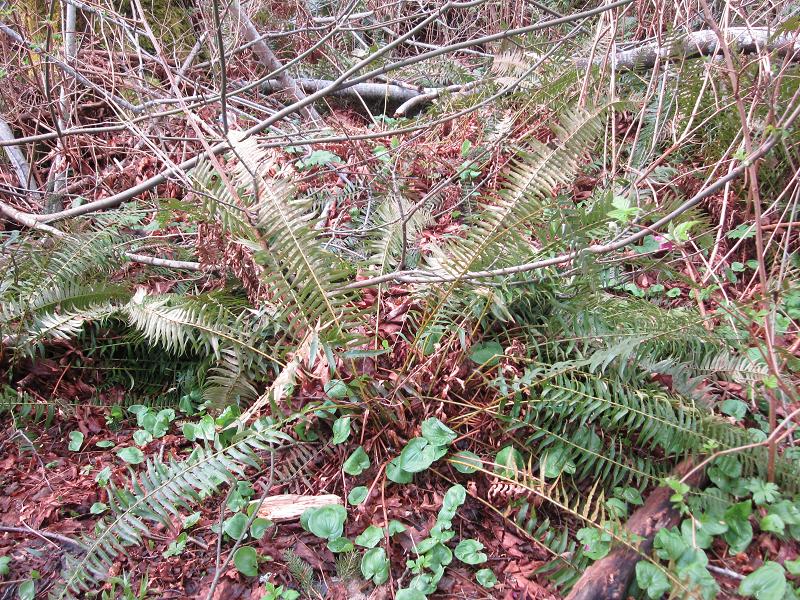
Sword Fern – As common here on the west coast as the Douglas Fir, this wide, flat-leafed fern has rows of long, thin knife-like leaves and can be found practically everywhere there is a smattering of shade. The fiddlehead-like protrusions that spring out of the fern base in the spring always seem to emerge fully open and drooping like sad little albino elephant trunks and don’t appear to be the least bit appetizing. Despite this, people keep telling me bits of this plant are edible… I’ve yet to muster the courage to find out.
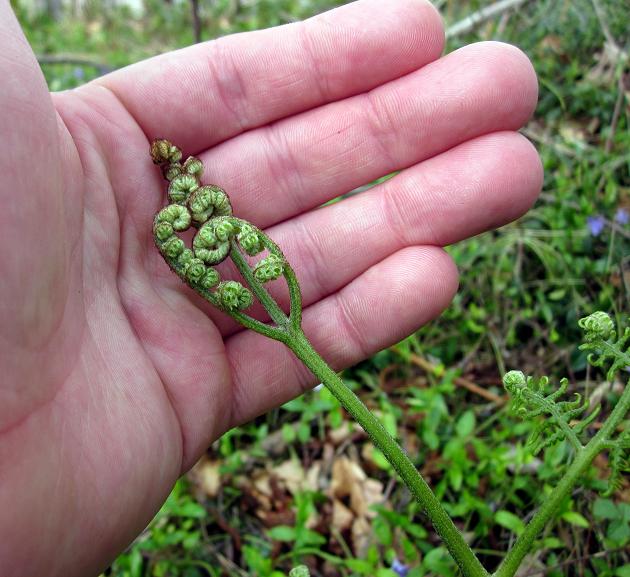
Bracken Fern – These solitary ferns grow fast, shooting dark green and sometimes burgundy stalks up and open before ever forming a proper fiddlehead. What they in fact resemble is more of a leper’s hand or monkey’s paw, making it easily distinguishable from other West coast ferns. Japanese foragers swear they are edible, yet scientists urge people not to risk stomach cancer eating these twisted little devils.
Of these four types, I can spot three in abundance in my back yard. The ones we foraged from the Beaver Lodge Lands were all Lady Ferns. Getting them off the rhizome was really easy, just pinch the fiddlehead an inch or so down below the spiral on the stock and give it a twist. Don’t get greedy and pinch more than half of the fiddleheads off a stump or it will wither.
Back in the kitchen, those little blackish-brown feathers I mentioned came off with some careful massaging under cold running water, followed by a long soak to rid the coils of any unwanted grit or pests. Then I plunked them into simmering water along with a tablespoon of salt for about eight minutes. Some of their beautiful green colour was lost, but they remained surprisingly crisp and springy to the tooth. *chomp*
The taste of fiddleheads has always been described to me (by foraging friends and the interwebs) as being similar to asparagus. But I’ve always likened ‘em to artichokes mixed with snow peas, but with a hint of bitterness to remind you it’s springtime. Their aroma is completely unique: One part chlorophyll and one part gin.
Fiddleheads are a pretty versatile ingredient; dense enough to be stir fried, pickled, steamed, sautéed in butter and plunked onto pasta. They are a particularly good friend to invite to brunch, pairing well with eggs and looking really cool on top of tarts and quiches. I’m thinking of frying mine in tempura batter and dipping them in a miso-mayo… but that’s not set in stone. Anyway, there’s still two more weeks of picking left so I’ve got time to try all manner of dishes.
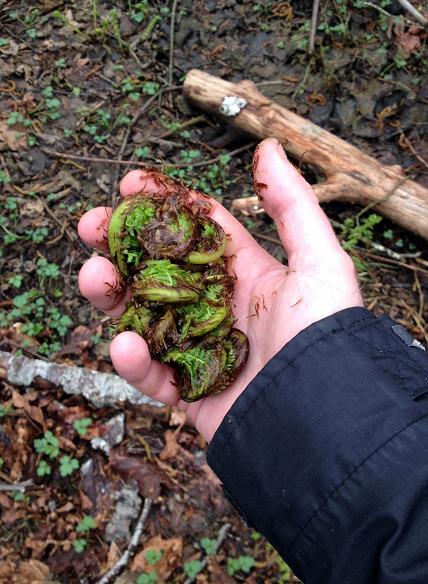 One last thing… I can’t stress enough how inherently “wild” these little buggers are. They’re bitter and slightly toxic, a textbook “acquired taste” in the best of circumstances, and a mild stomach ache waiting to happen for people who are unused to foraged foods. I’ve had friends who are very adventurous eaters with a lifetime in the cooking industry (which means they’re guts are fortified with liberal amounts of grease ‘n alcohol) eat heavily blanched Lady Ferns and still get mildly ill after dinner.
One last thing… I can’t stress enough how inherently “wild” these little buggers are. They’re bitter and slightly toxic, a textbook “acquired taste” in the best of circumstances, and a mild stomach ache waiting to happen for people who are unused to foraged foods. I’ve had friends who are very adventurous eaters with a lifetime in the cooking industry (which means they’re guts are fortified with liberal amounts of grease ‘n alcohol) eat heavily blanched Lady Ferns and still get mildly ill after dinner.
Scary right? Well not really, just be careful to properly identify the ferns you are picking, wash and blanch ‘em really well and don’t eat a whole bathtub full in one night. Fortune favours the bold!
Update : I found this older article by Hank Shaw that makes a case for eating bracken fern. Still not willing to risk it, but still… Fascinating stuff.
http://honest-food.net/2011/06/24/bracken-fern-food-or-poison/
Branken fee is a common vegetable in the area called Sichuan China.
Bracken ferns are edible, are used quite a bit in Asian foods, particularly Korean. Called gosari, they are a key ingredient in bibimbap, and can be found dried or reconstituted in many Asian supermarkets. Cheers.
Thanks for the info James! Since posting this (wow, five years… that went fast) I’ve been out with a couple people who have sworn brackens are edible as well. I’m willing to give ’em a shot!
I’m Japanese living in the PNW. Just picked both Lady Fern and Bracken today on my hike!
If you plan on eating Bracken, they do need to be prepared right. We boil them with a little baking soda in the water first. After that we let them sit in cold water, changing out the water a couple times to remove any taste of baking soda. Then eat however you like! Hope that helps!
Hi Reina.
Thank you so much for the instructions on preparing bracken fern!
I will try this method this year and let you know how it goes.
As Simon always says, “always go with someone who knows what’s up”
You are our Obi-Wan
Cheers.
It’s about that time of year for lady ferns 😀
I like them very small, then they are more mild.
A blanch + stir fry works well.
Bracken I cooked once, tasted like cancer to me 😉
However, I have learned since that the trick is to sun dry them first, before reconstituting them for dishes. The sun dry is rumored to remove toxicity.
Hey Toni. Long time, no forage!
I never seem to have enough time to get out there and get the really small ones, but you’ve inspired me to get my act together.
Bracken is still a bit of a bugbear for me.
Cheers.
I found fiddle heads in the yard in Georgia and they aren’t in groups they are like single sticks in the ground. Are these edible?
Hi Gabe.
Without seeing a picture of them I can’t be completely sure of what species they are and therefore I would not recommend eating them.
All of the edible types of fiddleheads that I know of grow in groups from a central rhizome, so when you say they aren’t in groups that makes me think they might be bracken.
I’d avoid them.
Cheers.